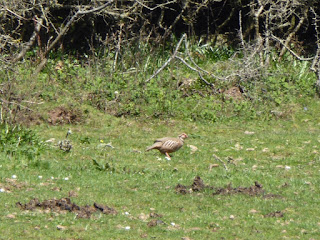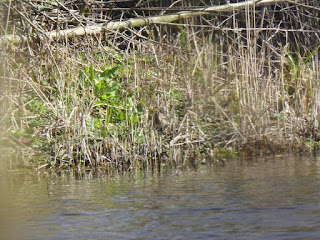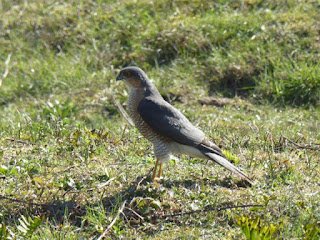A pug moth was found in the toilet block, I caught it in a pot and tried to get a photo before releasing it, however I had forgotten how neurotic and skittish pug moths are and it flew off before I could get a decent snap.
Pug Moth Sp.
Speckled Wood
Speckled Wood
Red Legged Partridge
Water Pipit
Water Pipit
Water Pipit
Water Pipit
Sunday March 26th was another beautiful sunny day but again with the keen and cool wind and so I decided to finish my week off as I started it with a trip to the River Exe, this time catching the train to Dawlish and walking to Dawlish Warren for a look around. At Dawlish a grey wagtail was feeding along the stream leading down to the beach with the 3 adult black swans and the lone small cygnet feeding nearby.
Grey Wagtail, Dawlish
The sea was very choppy and rough but I managed to find 2 great crested grebe, a female common scoter and a pair of red breasted merganser offshore along with the usual shag, cormorant, herring gull and great black backed gull.
I arrived at the main pond to find a pair of birders scanning the reeds only to be informed that my target bird, a Jack snipe that has been present by the upturned boats and showing well for a few days now, had moved off and out of sight just a short while before. I decided to wander off to view the area by the upturned boats from a different position and found the bird hidden amongst the reeds and surprisingly difficult to pick out against the vegetation. I popped back to the 2 birders to let them know where it was before returning to my original spot and managed to get some fairly decent views although the bird mostly slept with its head tucked under its wing. Occasionally it would wake up and preen before returning to sleep but when it was awake it constantly bobbed up and down in a most peculiar fashion, a bit like a wagtail constantly tail wagging I suppose. It was nice to see a Jack snipe on the deck, I have only ever seen them in flight, and its short bill and dumpy profile reminded me of a miniature woodcock - cue some more awful record shot photos.
Jack Snipe - in the reeds to the right of the blue boat
Jack Snipe
Jack Snipe
Jack Snipe
Jack Snipe
Jack Snipe
Jack Snipe
While watching the Jack snipe I also saw a male reed bunting, a female cirl bunting, a little grebe, a pair of mallard, 2 moorhen and singing chiffchaffs and a decent view of a water rail feeding along the reed edge before it realised it was being watched and disappeared into the reeds.
Water Rail - record shot
A walk around the Greenland Lake area gave a very nice view of a hunting male sparrowhawk looking gorgeous in the bright light. However I was less enamoured with it when I watched it chasing after a small bird which I initially thought was a bullfinch due to catching a flash of a white rump. A better view of the bird and I realised it was in fact a wheatear, my first of the year - luckily it escaped and flew off high to the north and I guess the sparrowhawk was just doing what sparrowhawks do.
Male Sparrowhawk
Male Sparrowhawk
Male Sparrowhawk
There were quite a few sand crocus flowering in the sunshine, such tiny flowers and so easily overlooked.
Sand Crocus
Sand Crocus
Sand Crocus
A speckled wood and a peacock were also seen but there was no sign of any commas reported yesterday.
Speckled Wood
A very nice day out and the end of another nice week off work with some interesting sightings and all within Devon and Cornwall.

























































